Laser Powder Cladding of Ti-6Al-4V α/β Alloy
Abstract
:1. Introduction
2. Materials and Methods
2.1. Materials
2.2. Cladding System Setup and Deposition Parameters
2.2.1. Preliminary Attempts of Laser Cladding Process
2.2.2. Final Attempts of Laser Cladding Process
2.3. Tribological Tests
3. Results and Discussion
3.1. Microstructural Analysis
3.1.1. Microstructure of the As-Received Specimen
3.1.2. Microstructure of Preliminary Attempts of the Laser Clad Ti-6Al-4V Specimens
3.1.3. Microstructure of Final Attempts of the Laser Clad Ti-6Al-4V Specimens
3.2. X-ray Diffractograms Compounds Analysis
3.3. Measurements of the Clad Layer Thickness
3.4. Dilution Ratio and Microhardness Profiles
Microhardness Profiles
3.5. Wear Resistance
4. Conclusions
- Deposition of 60% WC-40% NiCrBSi metal matrix composite layer on Ti-6Al-4V alloy was achieved by coaxial laser surface cladding on the alloy substrate with metallurgical bond. The obtained clad layer on the titanium alloy was divided into three zones according to different microstructure: clad, interface and the substrate zones.
- In the clad zone, WC particles were uniformly embedded in the NiCrBSi matrix, whereas the interface zone mainly consisted of epitaxial dendritic structures with a few WC particles.
- The higher heat input levels caused partial melting around the interface of WC particle/NiCrBSi matrix, while the particles themselves were mostly preserved.
- The thickness of the shallowest clad layer was 195 µm, and was associated with the lowest heat input (18 J·mm−2), while the deepest clad layer was 1083 µm and was achieved with the highest heat input value (60 J·mm−2).
- The matrix phases in the metal matrix coating (MMC) layers consist mainly of β-Ti, Ni, TiC, WC and W2C besides the existence β-Ti and α-Ti phases in the substrate material. For the range of the specific heat input from 18 to 30 J·mm−2, no presence of the TiC phase was observed, while at higher specific heat input, partially dissociation of the WC particles happened due to the adequate heat input level which causes that chemical reaction between the interaction phases.
- The dilution ratio of the laser clad layers was found to be directly proportional to the incident laser heat input. The microhardness values of the clad NiCrBSi-WC MMC layer on Ti-6Al-4V alloy were found to be directly proportional to the increase in the dilution ratio as well. The microhardness values were increased by three folds over that recorded for the as-received base alloy (1200 vs. 380 HV).
- After performing the pin-on-disk wear test on the clad layers, the wear resistance was observed to be increased by 400 times over the wear resistance of the as-received alloy.
- The optimum condition from the parameter window was at the highest specific heat input (59.5 J·mm−2), the best clad layer of uniformly distributed WC particles along the clad layer, and nonporous and crack free layer was achieved. It has the highest mean microhardness value (1200 HV) and a sufficient improvement in the wear resistance as well.
Acknowledgments
Author Contributions
Conflicts of Interest
References
- Li, J.; Chen, C.; Squartini, T.; He, Q. A study on wear resistance and microcrack of the Ti3Al/TiAl + TiC ceramic layer deposited by laser cladding on Ti-6Al-4V alloy. Appl. Surf. Sci. 2010, 257, 1550–1555. [Google Scholar] [CrossRef]
- Kartal, G.; Timur, S.; Urgen, M.; Erdemir, A. Electrochemical boriding of titanium for improved mechanical properties. Surf. Coat. Technol. 2010, 204, 3935–3939. [Google Scholar] [CrossRef]
- Savalani, M.M.; Ng, C.C.; Li, Q.H.; Man, H.C. In situ formation of titanium carbide using titanium and carbon-nanotube powders by laser cladding. Appl. Surf. Sci. 2012, 258, 3173–3177. [Google Scholar] [CrossRef]
- Tian, Y.S.; Chen, C.Z.; Li, S.T.; Huo, Q.H. Research progress on laser surface modification of titanium alloys. Appl. Surf. Sci. 2005, 242, 177–184. [Google Scholar] [CrossRef]
- Tian, Y.S.; Chen, C.Z.; Chen, L.X.; Huo, Q.H. Microstructures and wear properties of composite coatings produced by laser alloying of Ti-6Al-4V with graphite and silicon mixed powders. Mater. Lett. 2006, 60, 109–113. [Google Scholar] [CrossRef]
- Ion, J.C. Laser Processing of Engineering Materials: Principles, Procedure and Industrial Application; Butterworth-Heinemann: Boston, MA, USA, 2005; ISBN 9780750660792. [Google Scholar]
- Jang, J.H.; Joo, B.D.; Van Tyne, C.J.; Moon, Y.H. Characterization of deposited layer fabricated by direct laser melting process. Met. Mater. Int. 2013, 19, 497–506. [Google Scholar] [CrossRef]
- Zhang, D.; Cai, Q.; Liu, J.; He, J.; Li, R. Microstructural evolvement and formation of selective laser melting W-Ni-Cu composite powder. Int. J. Adv. Manuf. Technol. 2013, 67, 2233–2242. [Google Scholar] [CrossRef]
- Mok, S.H.; Bi, G.; Folkes, J.; Pashby, I. Deposition of Ti-6Al-4V using a high power diode laser and wire, Part I: Investigation on the process characteristics. Surf. Coat. Technol. 2008, 202, 3933–3939. [Google Scholar] [CrossRef]
- Sachdev, A.K.; Kulkarni, K.; Fang, Z.Z.; Yang, R.; Girshov, V. Titanium for automotive applications: Challenges and opportunities in materials and processing. JOM 2012, 64, 553–565. [Google Scholar] [CrossRef]
- Song, R.; Li, J.; Shao, J.Z.; Bai, L.L.; Chen, J.L.; Qu, C.C. Microstructural evolution and wear behaviors of laser cladding Ti2Ni/α(Ti) dual-phase coating reinforced by TiB and TiC. Appl. Surf. Sci. 2015, 355, 298–309. [Google Scholar] [CrossRef]
- Chen, Y.; Wang, H.M. Rapidly solidified MC carbide morphologies of a pulsed laser surface alloyedɤ-TiAl intermetallic with carbon. Scr. Mater. 2004, 50, 507–510. [Google Scholar] [CrossRef]
- Du, B.; Zou, Z.; Wang, X.; Qu, S. Laser cladding of in situ TiB2/Fe composite coating on steel. Appl. Surf. Sci. 2008, 254, 6489–6494. [Google Scholar] [CrossRef]
- Pu, Y.; Guo, B.; Zhou, J.; Zhang, S.; Zhou, H.; Chen, J. Microstructure and tribological properties of in situ synthesized TiC, TiN, and SiC reinforced Ti3Al intermetallic matrix composite coatings on pure Ti by laser cladding. Appl. Surf. Sci. 2008, 255, 2697–2703. [Google Scholar] [CrossRef]
- Yang, Y.; Zhang, D.; Yan, W.; Zheng, Y. Microstructure and wear properties of TiCN/Ti coatings on titanium alloy by laser cladding. Opt. Lasers Eng. 2010, 48, 119–124. [Google Scholar] [CrossRef]
- Varela, J.A.; Amado, J.M.; Tobar, M.J.; Mateo, M.P.; Yañez, A.; Nicolas, G. Characterization of hard coatings produced by laser cladding using laser-induced breakdown spectroscopy technique. Appl. Surf. Sci. 2015, 336, 396–400. [Google Scholar] [CrossRef]
- Dubourg, L.; Ursescu, D.; Hlawka, F.; Cornet, A. Laser cladding of MMC coatings on aluminium substrate: Influence of composition and microstructure on mechanical properties. Wear 2005, 258, 1745–1754. [Google Scholar] [CrossRef]
- Farayibi, P.K.; Folkes, J.; Clare, A.; Oyelola, O. Cladding of pre-blended Ti-6Al-4V and WC powder for wear resistant applications. Surf. Coat. Technol. 2011, 206, 372–377. [Google Scholar] [CrossRef]
- Zhang, C.; Fujii, M. Tribological Behavior of Thermally Sprayed WC Coatings under Water Lubrication. Mater. Sci. Appl. 2016, 7, 527–541. [Google Scholar] [CrossRef]
- Haldar, B.; Saha, R.; Agarwal, P.S.; Chattopadhyay, A.B. Laser Cladding of In-situ TiB, TiC and TiN Reinforced Ni-Ti MMC Coating on Ti-6Al-4V for Improving Tribological Performance. In Proceedings of the 4th International & 25th All India Manufacturing Technology, Design and Research Conference (AIMTDR 2012), Kolkata, West Bengal, India, 14–16 December 2012; pp. 796–801. [Google Scholar]
- Sun, R.L.; Lei, Y.W.; Niu, W. Laser clad TiC reinforced NiCrBSi composite coatings on Ti-6Al-4V alloy using a CW CO2 laser. Surf. Coat. Technol. 2009, 203, 1395–1399. [Google Scholar] [CrossRef]
- Liu, X.B.; Meng, X.J.; Liu, H.Q.; Shi, G.L.; Wu, S.H.; Sun, C.F.; Wang, M.D.; Qi, L.H. Development and characterization of laser clad high temperature self-lubricating wear resistant composite coatings on Ti-6Al-4V alloy. Mater. Des. 2014, 55, 404–409. [Google Scholar] [CrossRef]
- Kathuria, Y.P. Nd-YAG laser cladding of Cr3C2 and TiC cermets. Surf. Coat. Technol. 2001, 140, 195–199. [Google Scholar] [CrossRef]
- Lin, Y.; Lei, Y.; Fu, H.; Lin, J. Mechanical properties and toughening mechanism of TiB2/NiTi reinforced titanium matrix composite coating by laser cladding. Mater. Des. 2015, 80, 82–88. [Google Scholar] [CrossRef]
- Pang, W.; Man, H.C.; Yue, T.M. Laser surface coating of Mo-WC metal matrix composite on Ti6Al4V alloy. Mater. Sci. Eng. A 2005, 390, 144–153. [Google Scholar] [CrossRef]
- Xu, G.; Kutsuna, M.; Liu, Z.; Sun, L. Characteristic behaviours of clad layer by a multi-layer laser cladding with powder mixture of Stellite-6 and tungsten carbide. Surf. Coat. Technol. 2006, 201, 3385–3392. [Google Scholar] [CrossRef]
- Wu, P.; Zhou, C.Z.; Tang, X.N. Microstructural characterization and wear behavior of laser cladded nickel-based and tungsten carbide composite coatings. Surf. Coat. Technol. 2003, 166, 84–88. [Google Scholar] [CrossRef]
- Oerlikon Group—Balzers, Metco, Barmag, Neumag, Graziano, Fairfield << Oerlikon Corporate. Available online: https://www.oerlikon.com/en/ (accessed on 14 September 2017).
- Powell, J.; Henry, P.S.; Steen, W.M. Laser Cladding with Preplaced Powder: Analysis of Thermal Cycling and Dilution Effects. Surf. Eng. 1988, 4, 141–149. [Google Scholar] [CrossRef]
- Metallographic Etching. Available online: http://www.metallographic.com/Technical/Etching.htm (accessed on 7 January 2017).
- Steen, W.M.; Mazumder, J. Laser Material Processing; Springer: London, UK, 2010; ISBN 978-1-84996-061-8. [Google Scholar]
- Zhang, S.; Wu, W.T.; Wang, M.C.; Man, H.C. In-situ synthesis and wear performance of TiC particle reinforced composite coating on alloy Ti6Al4V. Surf. Coat. Technol. 2001, 138, 95–100. [Google Scholar] [CrossRef]
- Choudhury, A.R.; Ezz, T.; Chatterjee, S.; Li, L. Microstructure and tribological behaviour of nano-structured metal matrix composite boride coatings synthesized by combined laser and sol-gel technology. Surf. Coat. Technol. 2008, 202, 2817–2829. [Google Scholar] [CrossRef]
- Wu, P.; Chen, X.L.; Jiang, E.Y. Morphology and gradient distribution of WC phase in laser-clad NiCrBSiC-WC composite layers. Phys. Status Solidi Appl. Res. 2003, 199, 214–219. [Google Scholar] [CrossRef]
- Man, H.C.; Zhang, S.; Cheng, F.T.; Yue, T.M. Microstructure and formation mechanism of in situ synthesized TiC/Ti surface MMC on Ti-6Al-4V by laser cladding. Scr. Mater. 2001, 44, 2801. [Google Scholar] [CrossRef]
- Wang, X.H.; Zhang, M.; Liu, X.M.; Qu, S.Y.; Zou, Z.D. Microstructure and wear properties of TiC/FeCrBSi surface composite coating prepared by laser cladding. Surf. Coat. Technol. 2008, 202, 3600–3606. [Google Scholar] [CrossRef]
- Noskov, A.I.; Gilmutdinov, A.K.; Yanbaev, R.M. Effect of coaxial laser cladding parameters on bead formation. Int. J. Miner. Metall. Mater. 2017, 24, 550–556. [Google Scholar] [CrossRef]
- Schneider, M.F. Laser Cladding with Powder, Effect of Some Machining Parameters on Clad Properties; Universiteit Twente: Enschede, The Netherlands, 1998; p. 177. [Google Scholar]
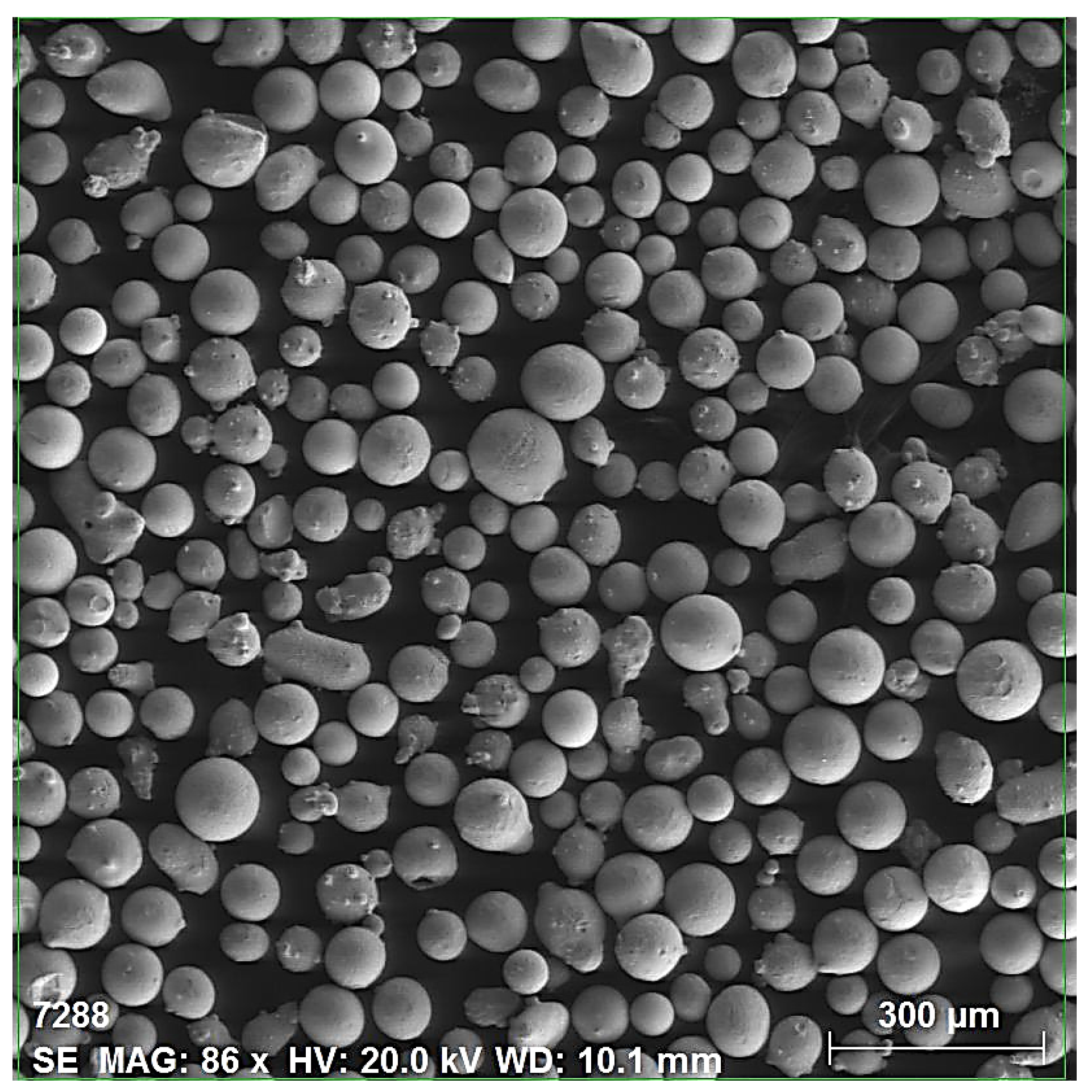
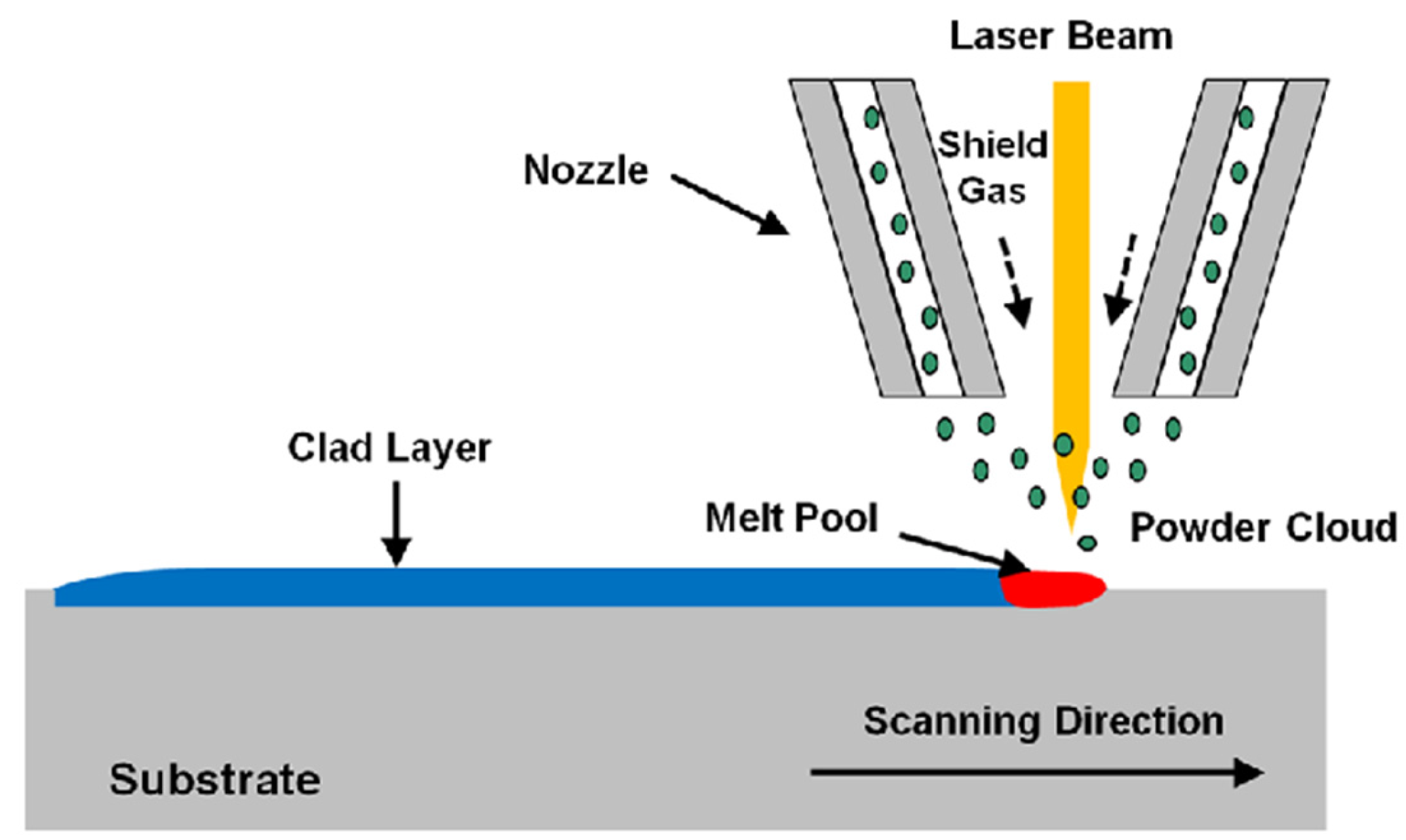
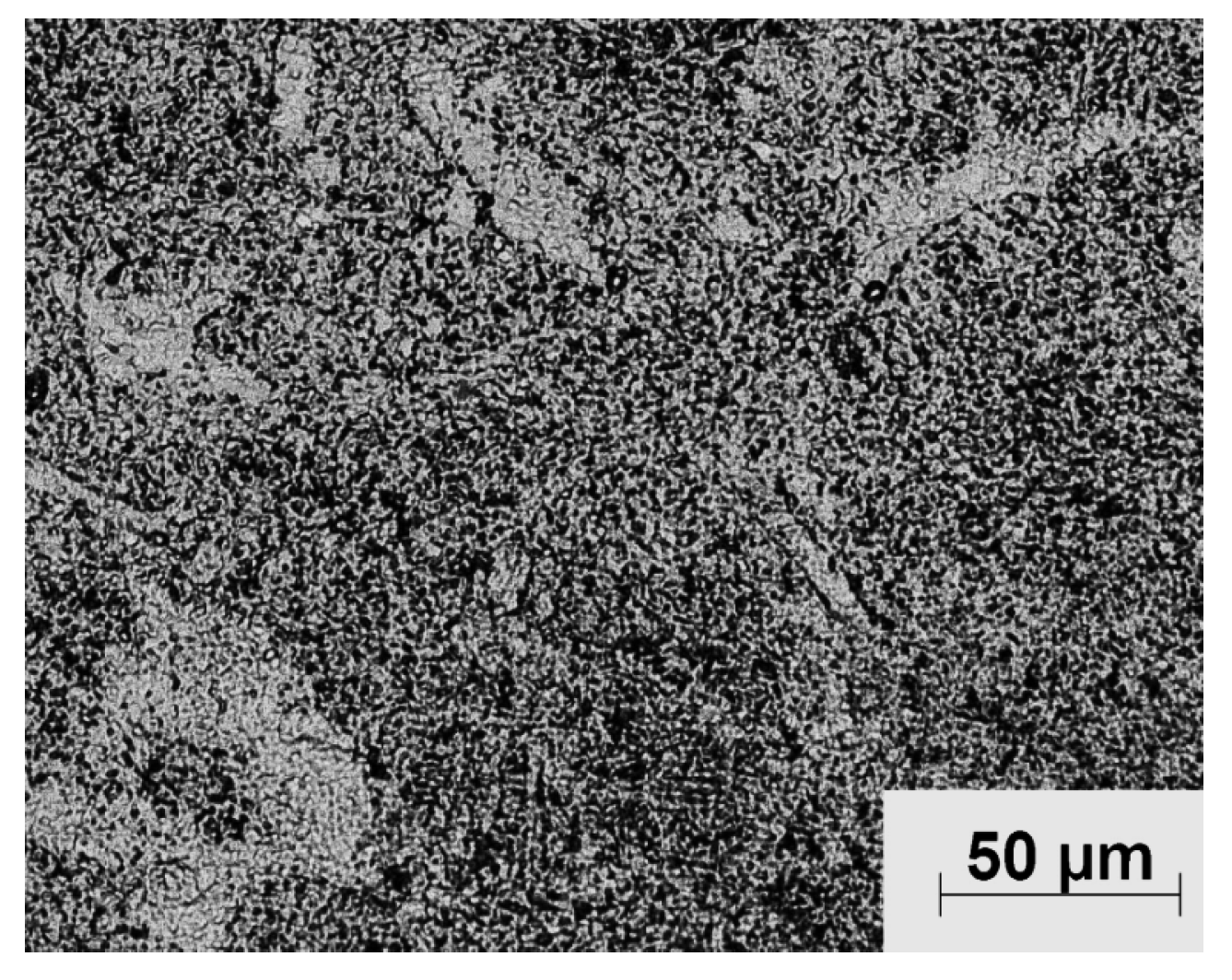


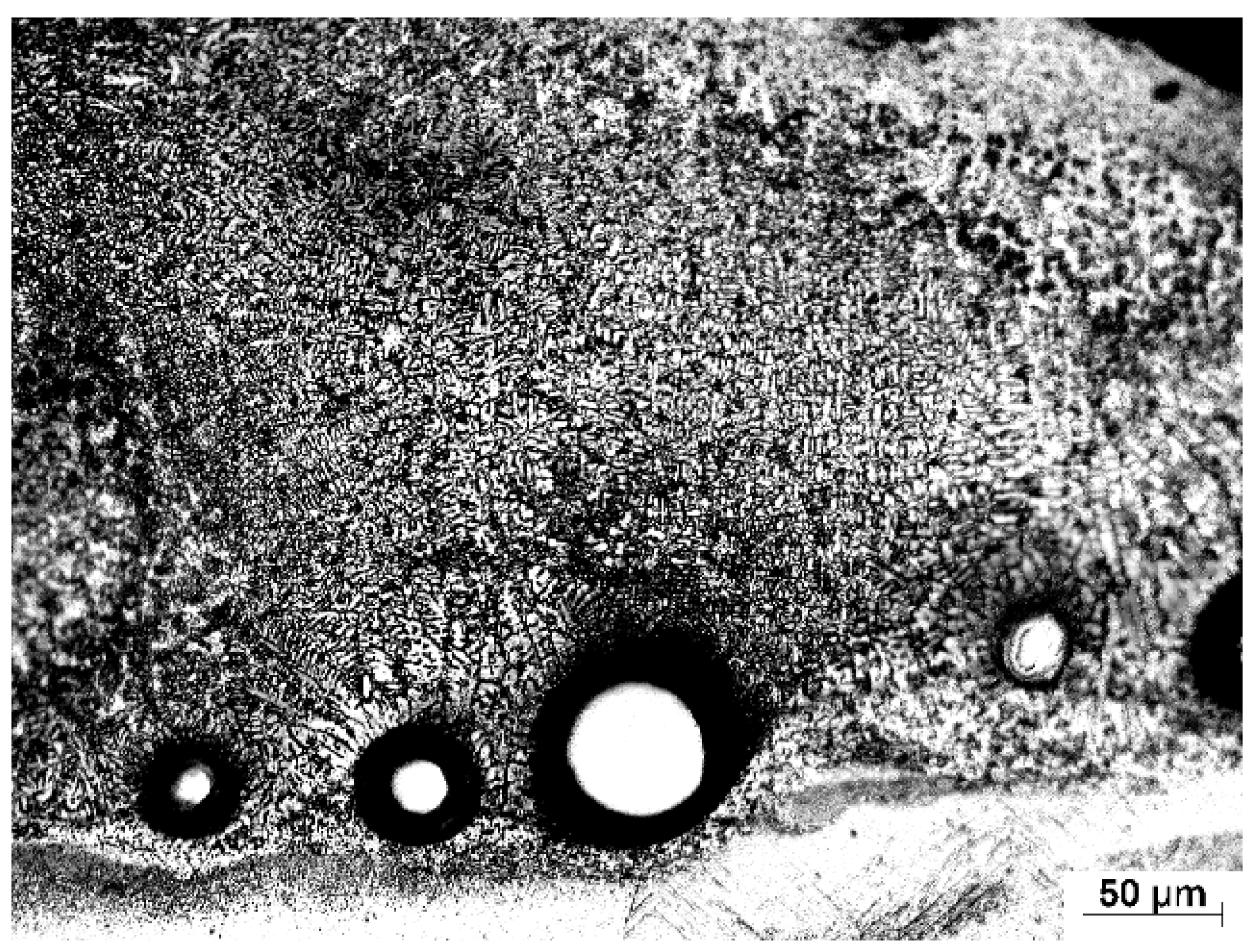
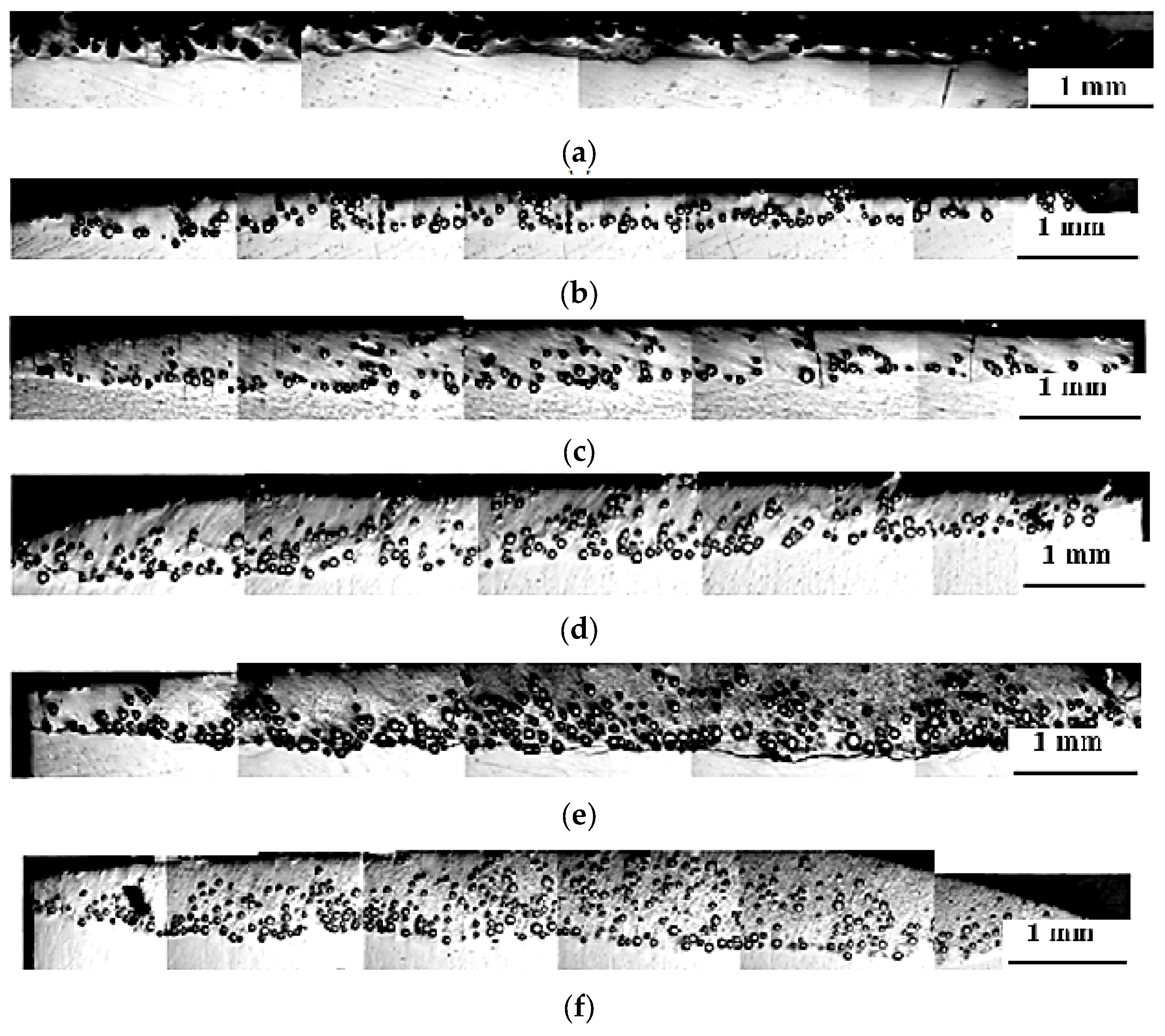
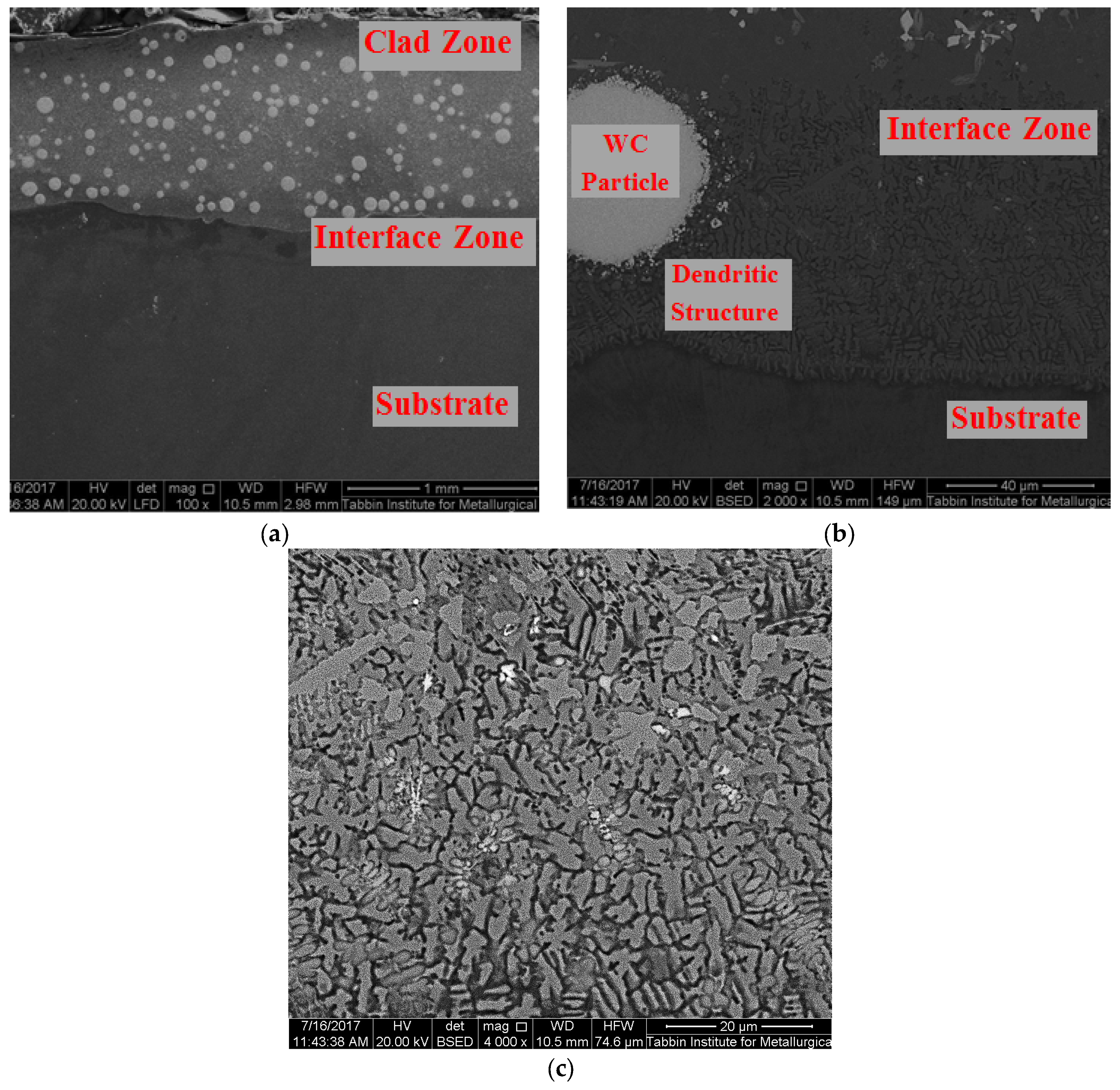
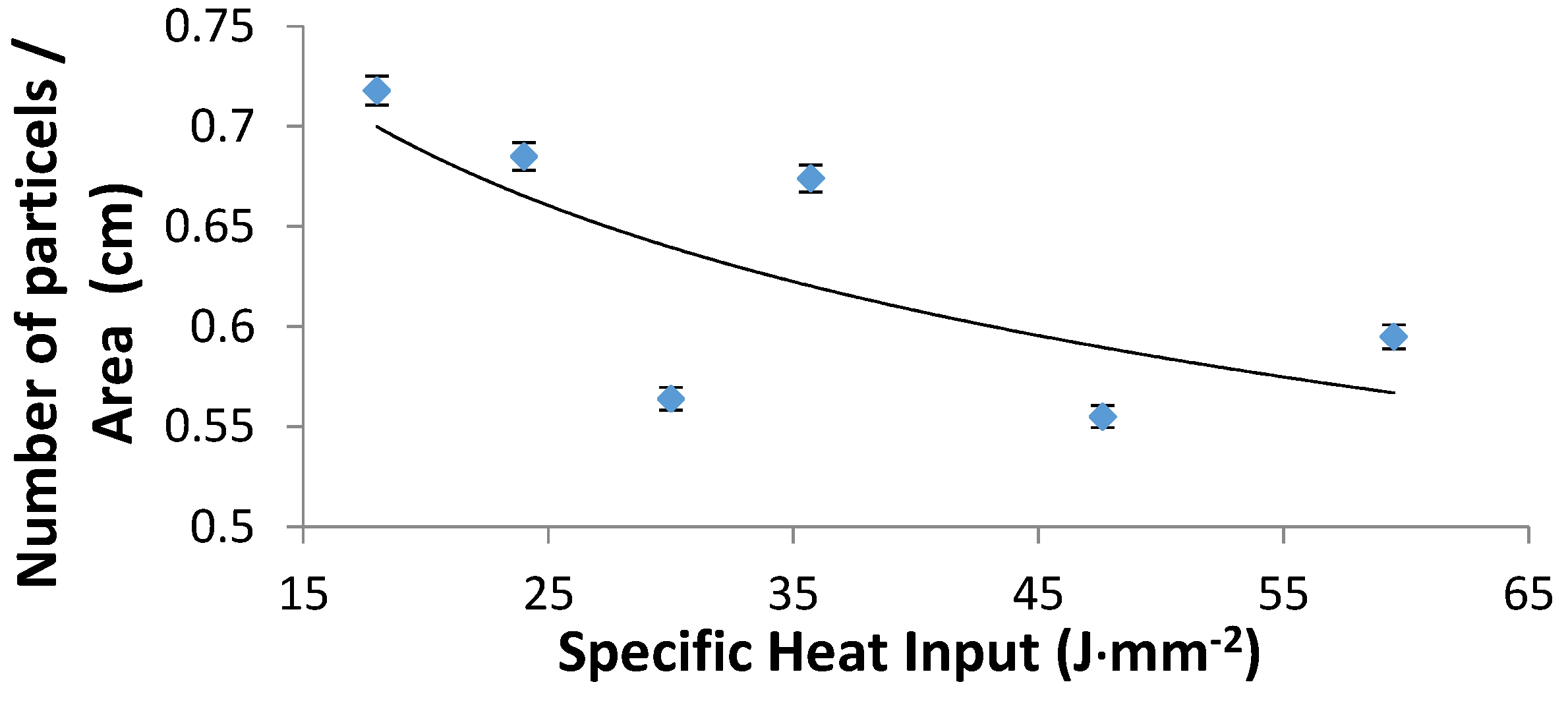
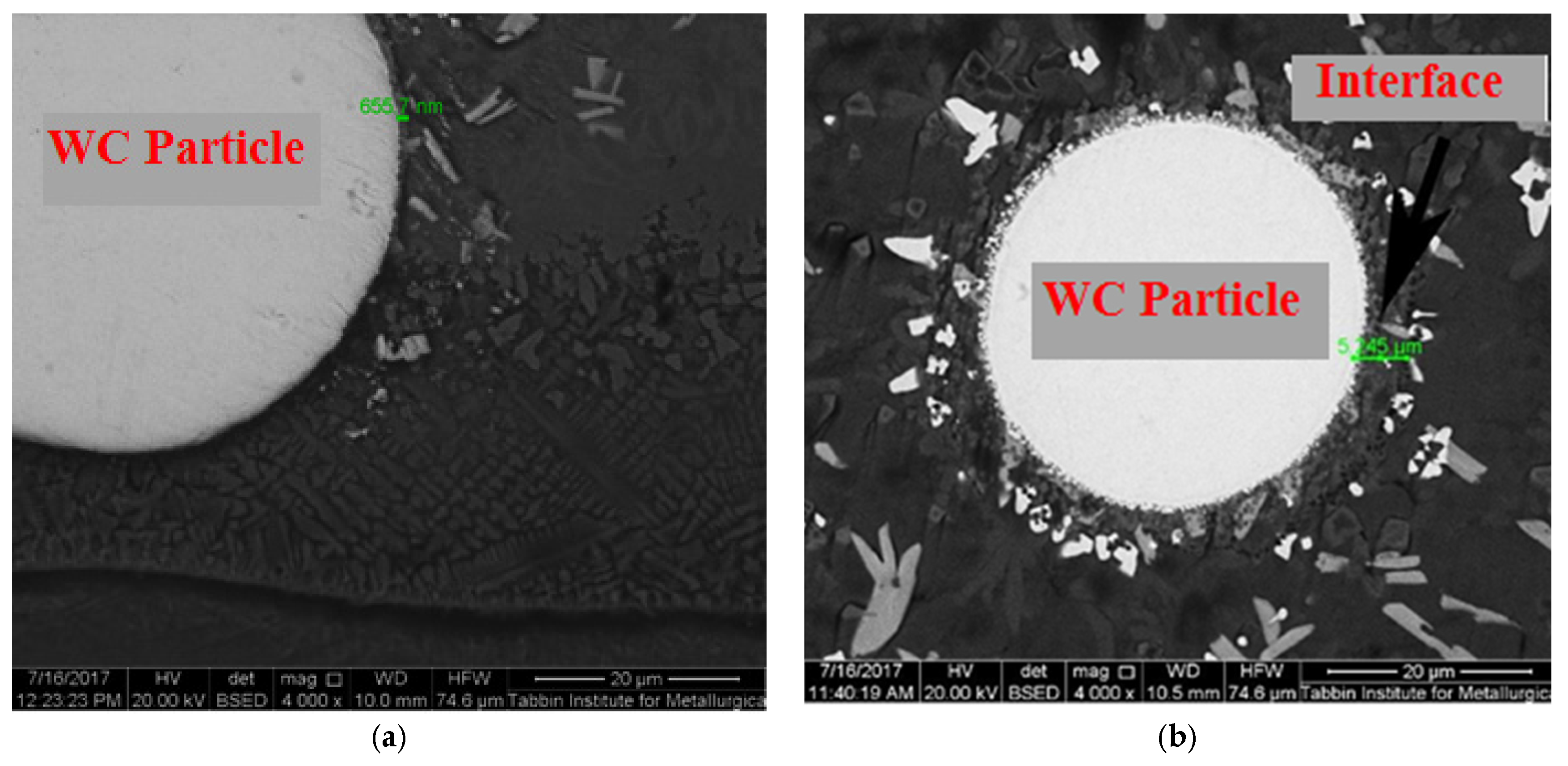

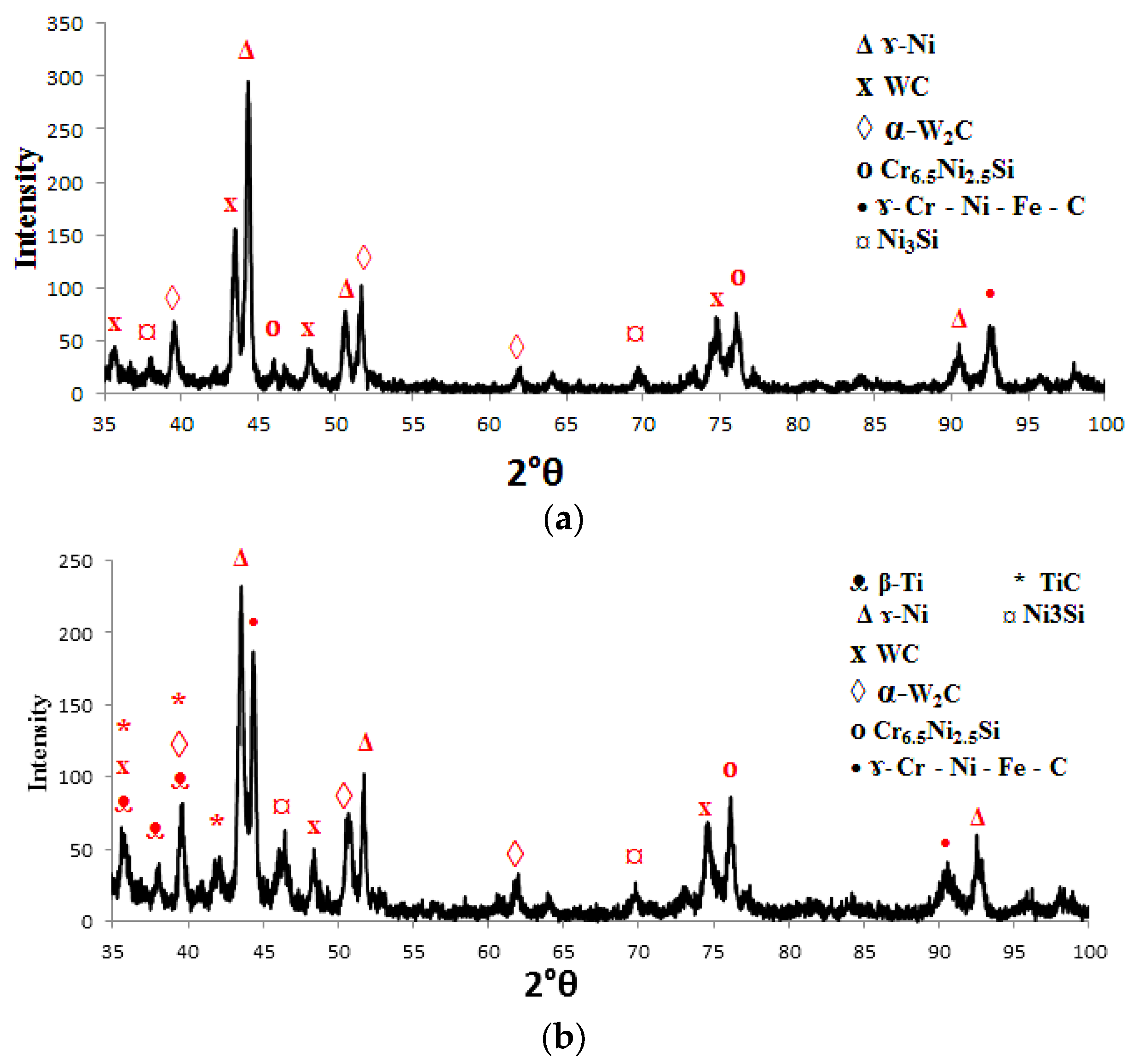
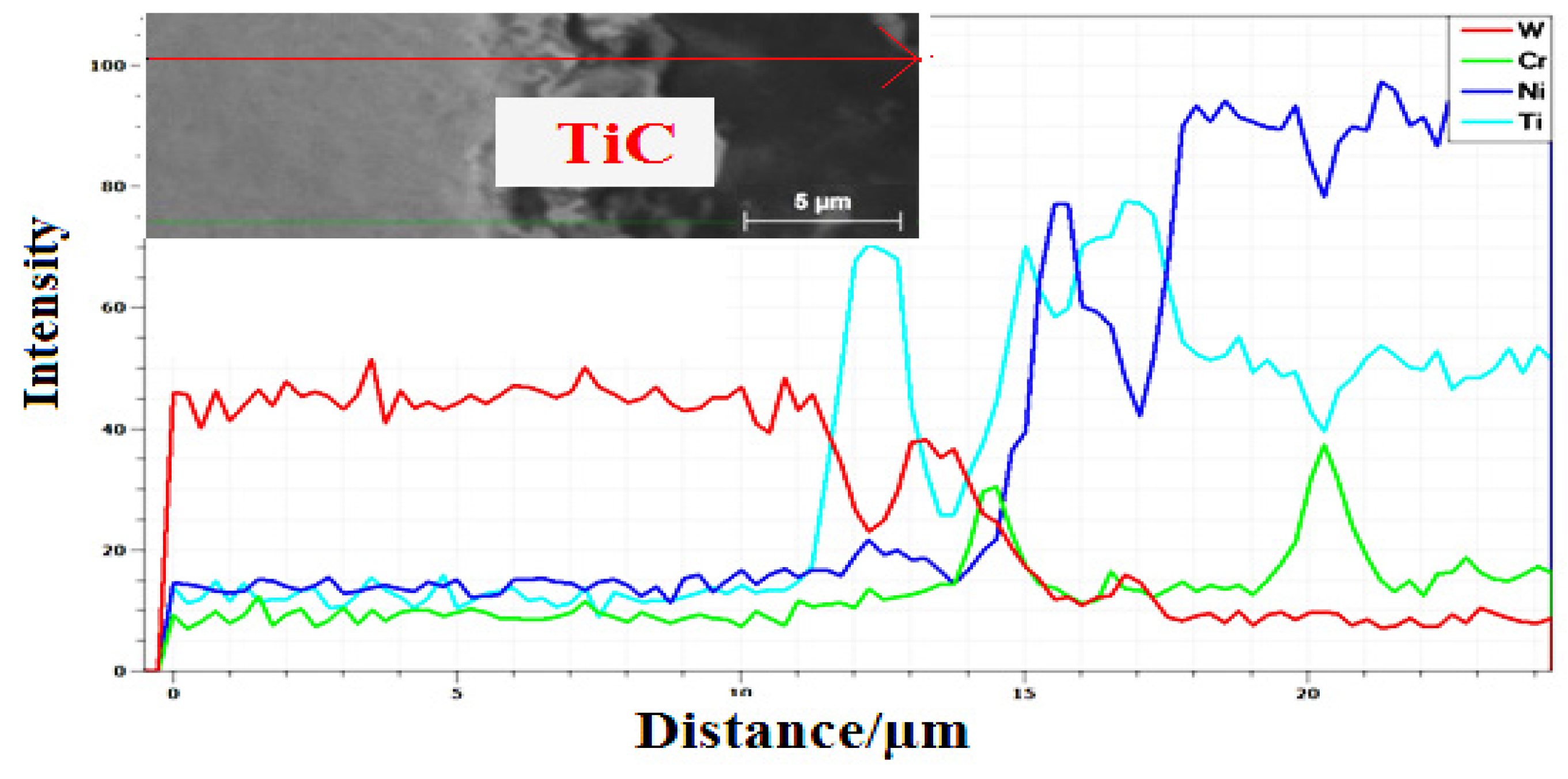
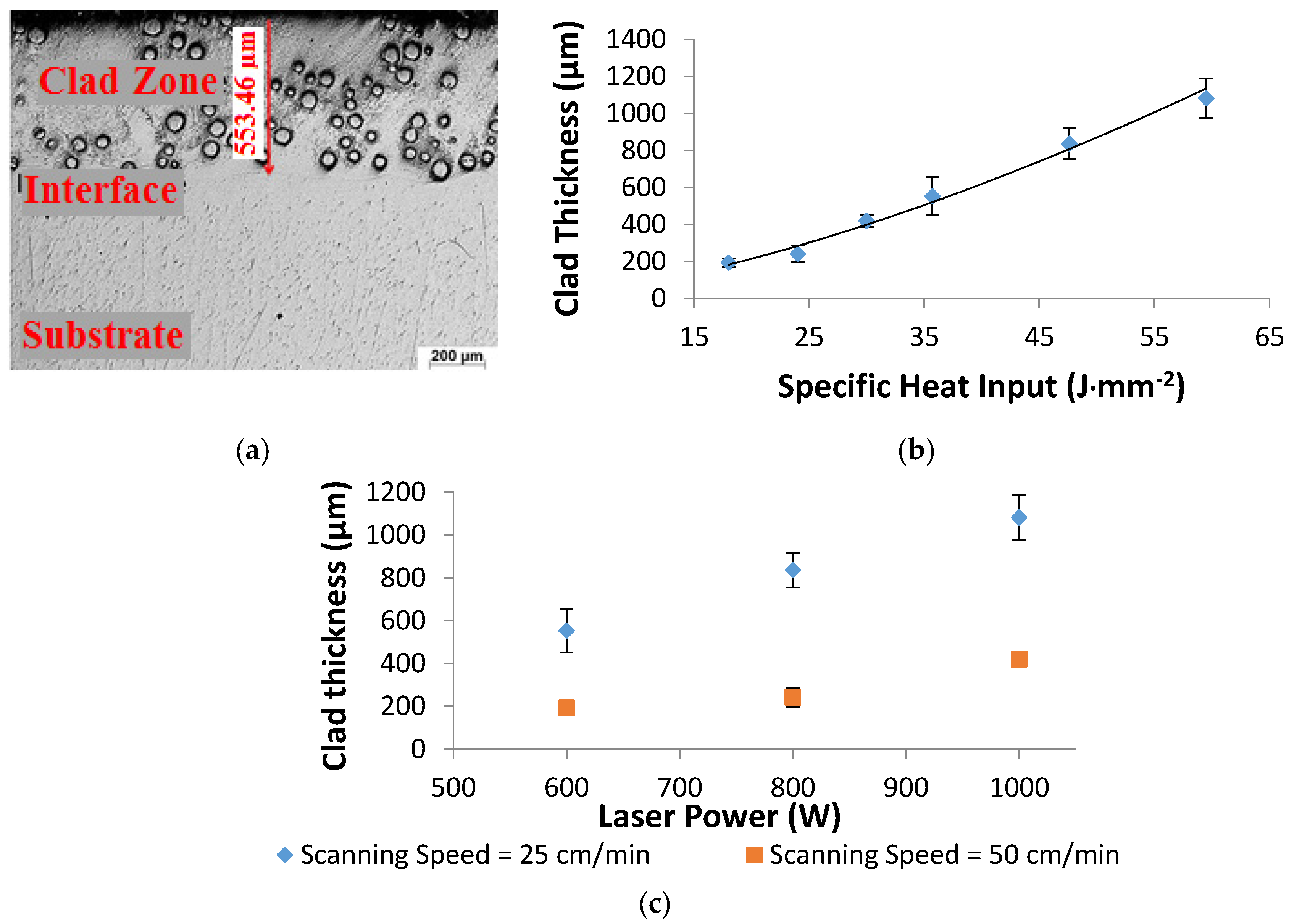
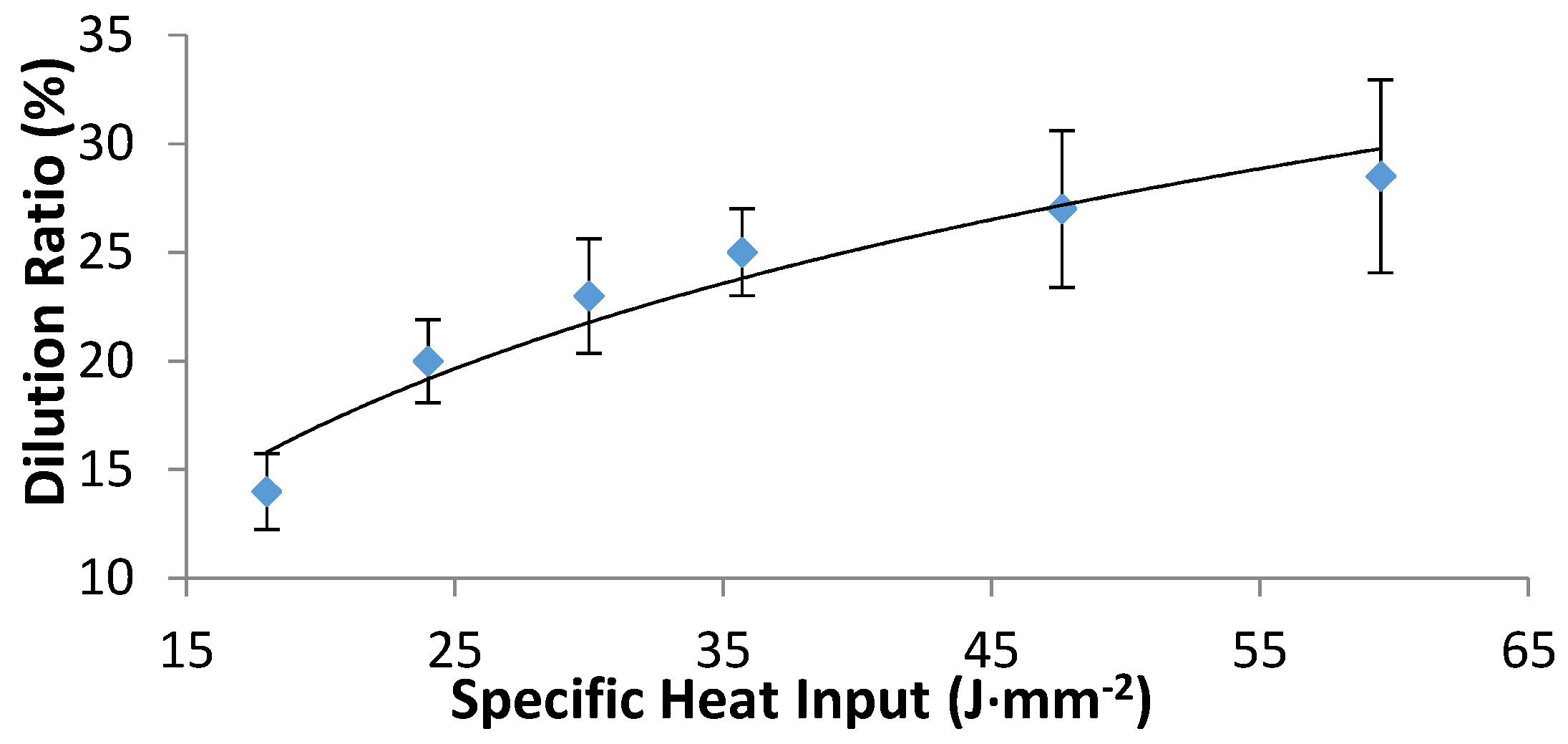
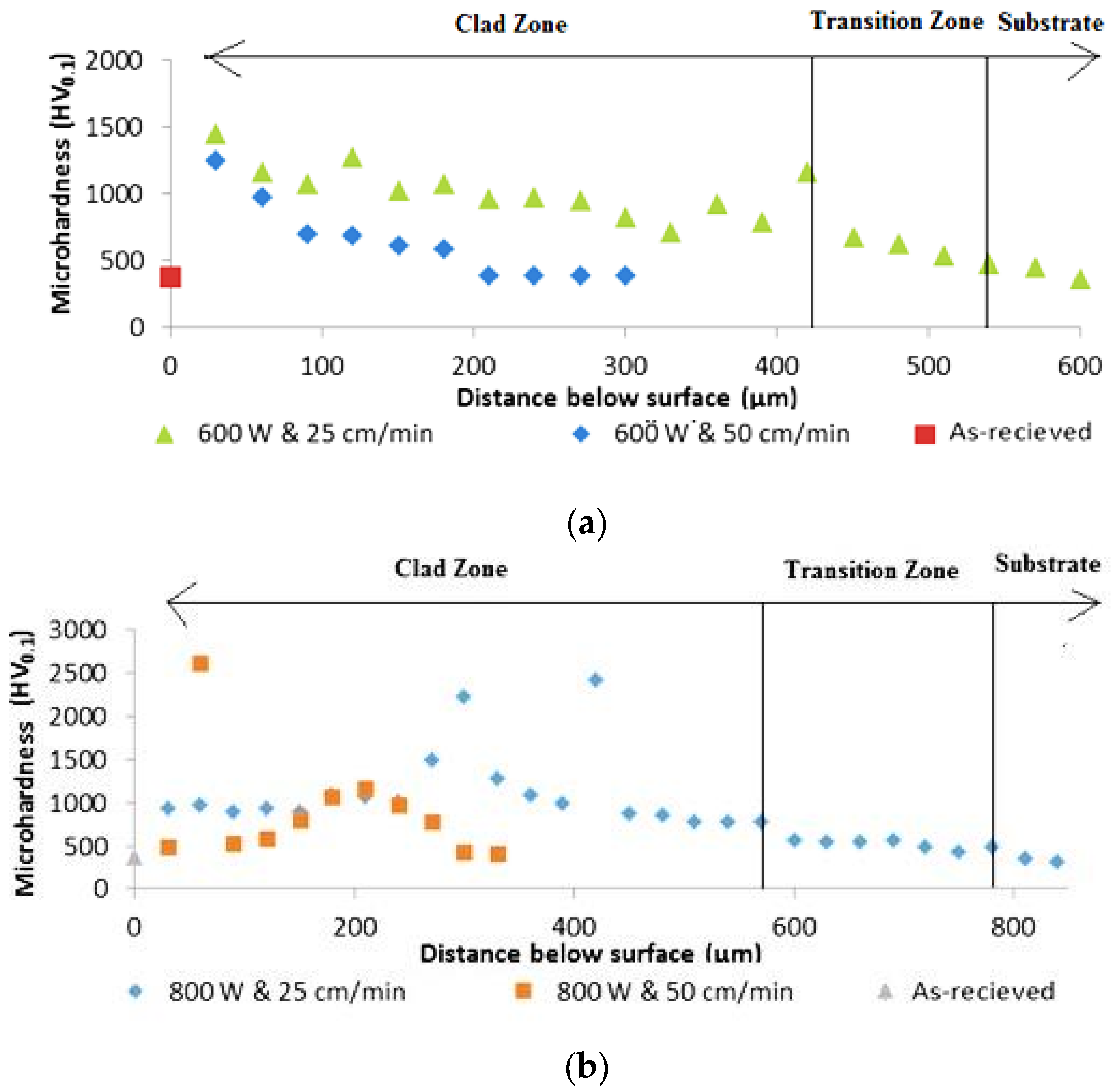
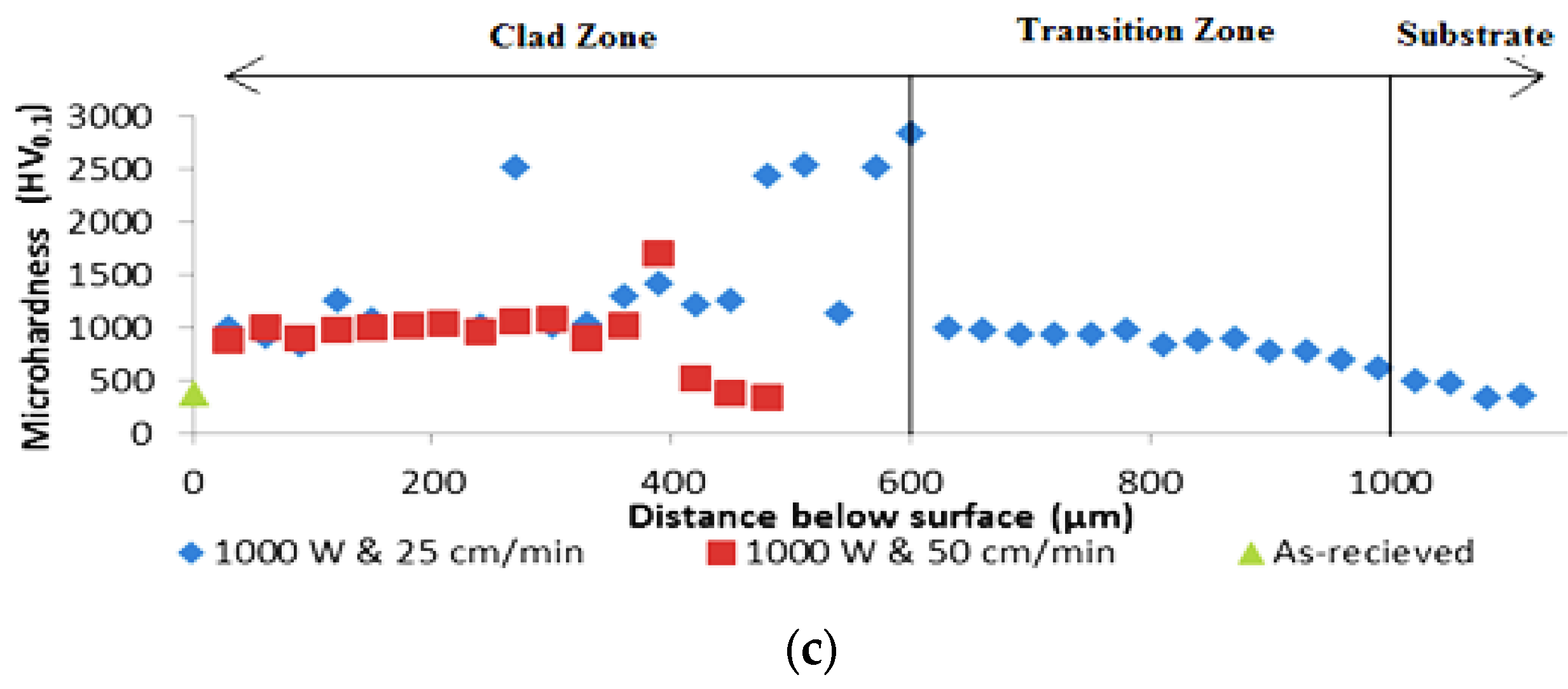

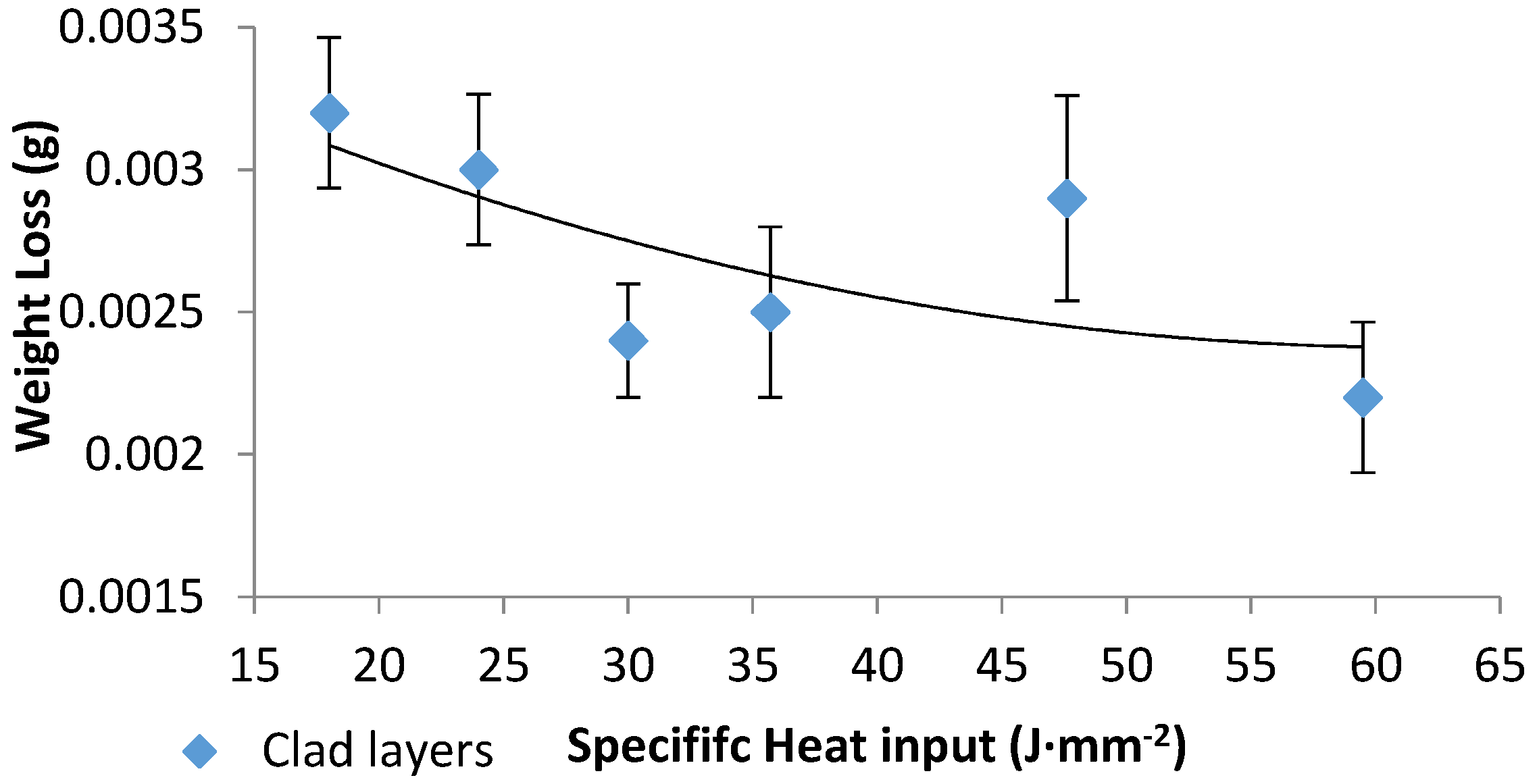
| Laser Processing Parameter | First Attempt | Second Attempt |
|---|---|---|
| Laser power (W) | 800 | 2000 |
| Scanning speed (cm·min−1) | 25, 50 | 25 |
| Powder flow rate (g·min−1) | 3 | 3 |
| Feeding gas (L·min−1) | 2 | 2 |
| Shielding gas (L·min−1) | 10 | 10 |
| Laser Cladding Parameters | Parameter Value |
|---|---|
| Laser power | 600, 800, 1000 W |
| Beam scanning speed | 25, 50 cm·min−1 |
| Powder flow rate | 6 g·min−1 |
| Feeding gas | 3 L·min−1 |
| Shielding gas | 15 L·min−1 |
| Defocus distance | 15 mm |
| Beam diameter | 4 mm |
© 2017 by the authors. Licensee MDPI, Basel, Switzerland. This article is an open access article distributed under the terms and conditions of the Creative Commons Attribution (CC BY) license (http://creativecommons.org/licenses/by/4.0/).
Share and Cite
Al-Sayed Ali, S.R.; Hussein, A.H.A.; Nofal, A.A.M.S.; Hasseb Elnaby, S.E.I.; Elgazzar, H.A.; Sabour, H.A. Laser Powder Cladding of Ti-6Al-4V α/β Alloy. Materials 2017, 10, 1178. https://doi.org/10.3390/ma10101178
Al-Sayed Ali SR, Hussein AHA, Nofal AAMS, Hasseb Elnaby SEI, Elgazzar HA, Sabour HA. Laser Powder Cladding of Ti-6Al-4V α/β Alloy. Materials. 2017; 10(10):1178. https://doi.org/10.3390/ma10101178
Chicago/Turabian StyleAl-Sayed Ali, Samar Reda, Abdel Hamid Ahmed Hussein, Adel Abdel Menam Saleh Nofal, Salah Elden Ibrahim Hasseb Elnaby, Haytham Abdelrafea Elgazzar, and Hassan Abdel Sabour. 2017. "Laser Powder Cladding of Ti-6Al-4V α/β Alloy" Materials 10, no. 10: 1178. https://doi.org/10.3390/ma10101178
APA StyleAl-Sayed Ali, S. R., Hussein, A. H. A., Nofal, A. A. M. S., Hasseb Elnaby, S. E. I., Elgazzar, H. A., & Sabour, H. A. (2017). Laser Powder Cladding of Ti-6Al-4V α/β Alloy. Materials, 10(10), 1178. https://doi.org/10.3390/ma10101178





